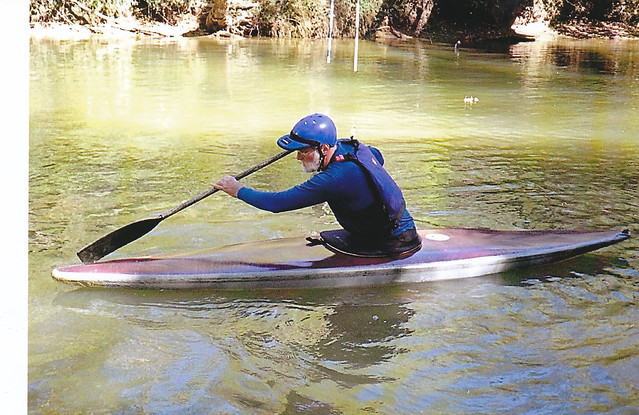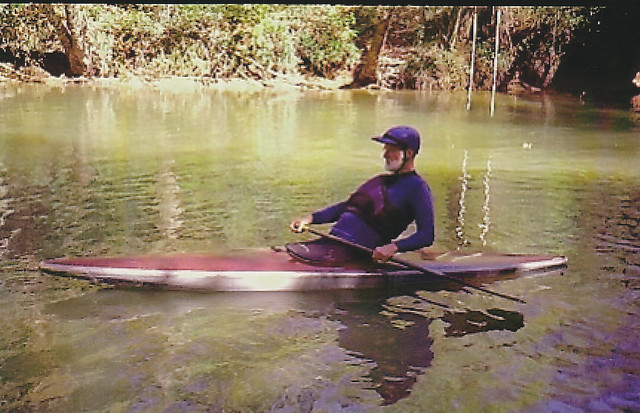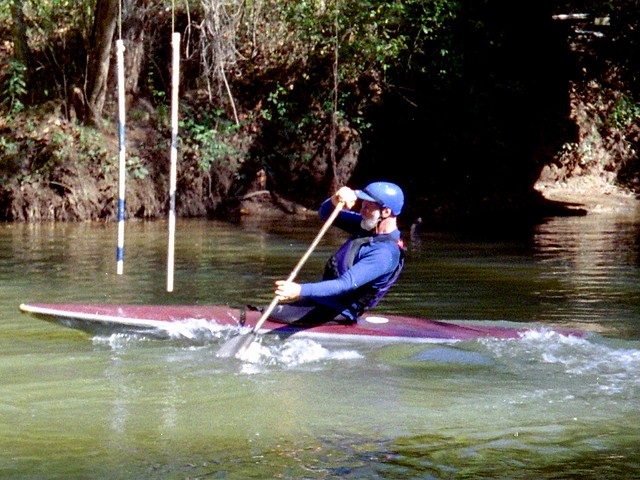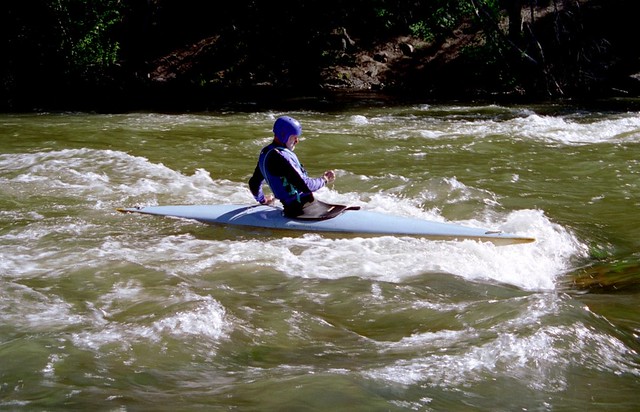Tippecanoe
Posted: Sun Aug 24, 2014 8:37 pm
Recently there was discussion in a thread about how with the right formula or factors, one could predict which boats would be more stable, less tippy, than others.
The thread did not give much attention to fore/aft asymmetry and how a boat's trim is set up to accomodate that asymmetry.
Certain boats, though relatively round or roly poly, are *functionally* very stable. They might feel a bit soft, but not "tippy". Examples I would cite are the Hahn and the Magnet, both relatively full from end to end, and both very close to symmetrical.
As c-boats and the kayaks from which they were "converted" evolved, the commonest change was a degree of swedeforming, where the stern became broader and flatter and the bow became narrower, perhaps less flat. Was the Gyramax swedeformed a bit? I don't recall. The Dagger Cascade, on the other hand, might have been a bit fishformed, broader in the bow.
A c-boat may come with a cockpit rim set in place. This means that the paddler's weight distribution and that of the boat as a whole is not easily adjusted. (Open boats are easier, as are converted kayaks because the cockpit is quite large.)
My first c-1 was a Hahn, and after wasting some time in a Sage, I bought a second hand Phoenix Seewun. It is a very swedeform boat. From the beginning, I noticed a tendency for the bow to bury and the stern to lift in rapids like Tablesaw. But I didn't know what the misbehavior meant.
Later, I bought a Millbrook Wide Ride, a somewhat swedeformed c-1. Mostly it has handled quite well, but I've noticed that it seems to make me sit up a bit too straight, because of the cockpit position. The bow is a teensy bit too grabby.
Both of these c-boats need their cockpits moved back a couple of inches, at least with a very tall, heavy paddler like me in them. They need to be working more on their broad, wide tail section, not on their fast, sharp noses.
Here are a couple of shots of the Wide Ride. I'm not trying to look competent, I'm just posturing to show you how the bow and stern maybe aren't responding quite the way they should. Functionally, the bow is too low volume and grabby.
 WideRide_0002 by ezwater, on Flickr
WideRide_0002 by ezwater, on Flickr
 WideRide_0001 by ezwater, on Flickr
WideRide_0001 by ezwater, on Flickr
 wideride3 by ezwater, on Flickr
wideride3 by ezwater, on Flickr
Here I am trying to surf in the Phoenix, at a tiny hole on the Conejos in Colorado. I'm having to lean WAY back to keep the bow from getting stuffed or purling or whatever.
 94co14 by ezwater, on Flickr
94co14 by ezwater, on Flickr
The Phoenix Seewun was an early attempt at a low end race boat, and it never amounted to much. But if I had solved the technical problem of moving the (strongly tilted) cockpit a couple of inches sternward, it would have helped the boat keep its nose out of the cat pan.
The Wide Ride, I believe, can be modified by splitting the cockpit at the rear, and spreading the "wings" to make room for my butt. The Wide Ride has the potential to be a very sharp handling boat when its working zone is moved sternward.
These issues can be approached similarly with ww open boats. Is the hull swedeform? Then move the saddle back to make sure the working zone is back of the boat's midpoint.
Fishform open boats, surprisingly, should not be pedestaled too far "forward". If they are, they will swivel and wallow on their bow. They need to be rigged a bit farther back so the fishy zone can track and contribute to speed.
So the upshot is, if a boat is quite asymmetrical, and if the paddler's avoirdupois is in the wrong place, the boat may feel "tippy". It may feel like it is swiveling ln its nose, or as if the river is working the stern.
This can get complicated, but then it's interesting. Sort of.
((Incidentally, I think the Wide Ride deserves a higher rating, and it compared favorably to certain other pocket c-1s I have tried, including the Magnet, the MiniMax, and the Atom. Although a somewhat conservative design, the Wide Ride is very capable, and has no serious faults. ))
The thread did not give much attention to fore/aft asymmetry and how a boat's trim is set up to accomodate that asymmetry.
Certain boats, though relatively round or roly poly, are *functionally* very stable. They might feel a bit soft, but not "tippy". Examples I would cite are the Hahn and the Magnet, both relatively full from end to end, and both very close to symmetrical.
As c-boats and the kayaks from which they were "converted" evolved, the commonest change was a degree of swedeforming, where the stern became broader and flatter and the bow became narrower, perhaps less flat. Was the Gyramax swedeformed a bit? I don't recall. The Dagger Cascade, on the other hand, might have been a bit fishformed, broader in the bow.
A c-boat may come with a cockpit rim set in place. This means that the paddler's weight distribution and that of the boat as a whole is not easily adjusted. (Open boats are easier, as are converted kayaks because the cockpit is quite large.)
My first c-1 was a Hahn, and after wasting some time in a Sage, I bought a second hand Phoenix Seewun. It is a very swedeform boat. From the beginning, I noticed a tendency for the bow to bury and the stern to lift in rapids like Tablesaw. But I didn't know what the misbehavior meant.
Later, I bought a Millbrook Wide Ride, a somewhat swedeformed c-1. Mostly it has handled quite well, but I've noticed that it seems to make me sit up a bit too straight, because of the cockpit position. The bow is a teensy bit too grabby.
Both of these c-boats need their cockpits moved back a couple of inches, at least with a very tall, heavy paddler like me in them. They need to be working more on their broad, wide tail section, not on their fast, sharp noses.
Here are a couple of shots of the Wide Ride. I'm not trying to look competent, I'm just posturing to show you how the bow and stern maybe aren't responding quite the way they should. Functionally, the bow is too low volume and grabby.
 WideRide_0002 by ezwater, on Flickr
WideRide_0002 by ezwater, on Flickr WideRide_0001 by ezwater, on Flickr
WideRide_0001 by ezwater, on Flickr wideride3 by ezwater, on Flickr
wideride3 by ezwater, on Flickr Here I am trying to surf in the Phoenix, at a tiny hole on the Conejos in Colorado. I'm having to lean WAY back to keep the bow from getting stuffed or purling or whatever.
 94co14 by ezwater, on Flickr
94co14 by ezwater, on Flickr The Phoenix Seewun was an early attempt at a low end race boat, and it never amounted to much. But if I had solved the technical problem of moving the (strongly tilted) cockpit a couple of inches sternward, it would have helped the boat keep its nose out of the cat pan.
The Wide Ride, I believe, can be modified by splitting the cockpit at the rear, and spreading the "wings" to make room for my butt. The Wide Ride has the potential to be a very sharp handling boat when its working zone is moved sternward.
These issues can be approached similarly with ww open boats. Is the hull swedeform? Then move the saddle back to make sure the working zone is back of the boat's midpoint.
Fishform open boats, surprisingly, should not be pedestaled too far "forward". If they are, they will swivel and wallow on their bow. They need to be rigged a bit farther back so the fishy zone can track and contribute to speed.
So the upshot is, if a boat is quite asymmetrical, and if the paddler's avoirdupois is in the wrong place, the boat may feel "tippy". It may feel like it is swiveling ln its nose, or as if the river is working the stern.
This can get complicated, but then it's interesting. Sort of.
((Incidentally, I think the Wide Ride deserves a higher rating, and it compared favorably to certain other pocket c-1s I have tried, including the Magnet, the MiniMax, and the Atom. Although a somewhat conservative design, the Wide Ride is very capable, and has no serious faults. ))